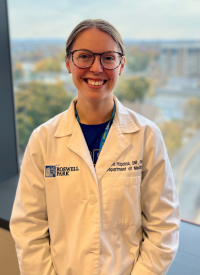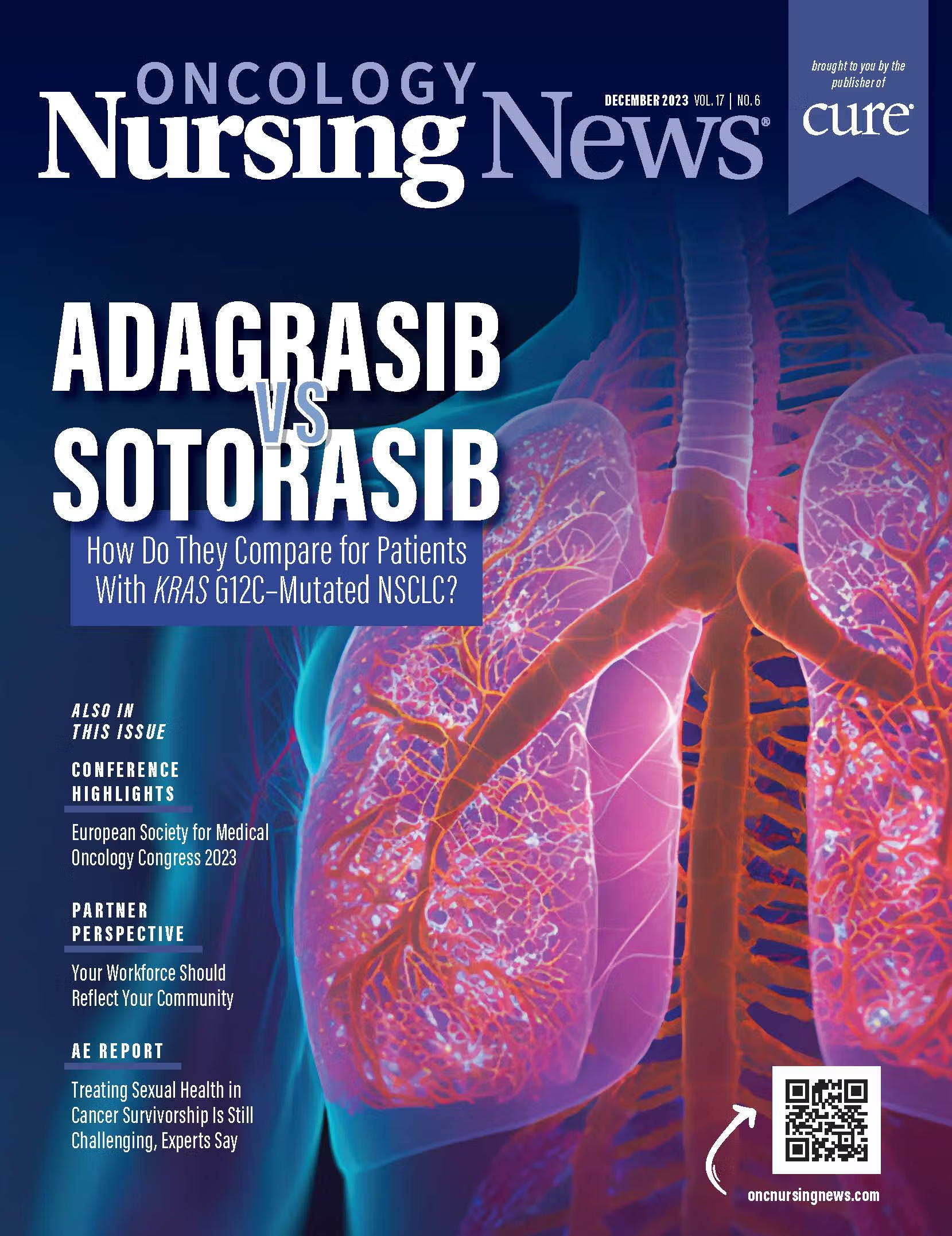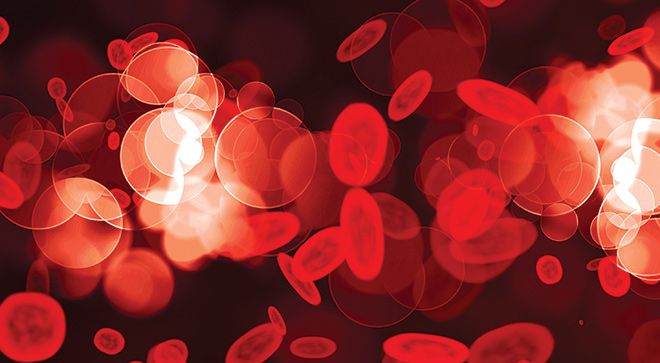Adagrasib vs Sotorasib: How Do They Compare for Patients With KRAS G12C– Mutated NSCLC?
New targeted therapies offer certain patients with non–small cell lung cancer more second-line treatment options.
IN THE PAST, patients with non–small cell lung cancer (NSCLC) who harbored a specific KRAS mutation called G12C had few treatment options after chemotherapy and immunotherapy stopped working.
But in May 2021, the FDA granted accelerated approval to sotorasib (Lumakras), a targeted therapy for adult patients with advanced NSCLC who have received at least 1 prior systemic therapy.1 Considered a breakthrough in the fight against NSCLC, this approval also paved the way for the FDA to approve a second KRAS G12C–directed anticancer medication, adagrasib (Krazati), in December 2022. Adagrasib was approved for patients with pretreated locally advanced or metastatic disease.2
Both therapies are considered promising treatments for patients with advanced or metastatic KRAS G12C–mutated NSCLC.
Exploring 2 Powerful Treatment Options
BETH SANDY, MSN, CRNP, a thoracic oncology nurse practitioner at Abramson Cancer Center at the University of Pennsylvania in Philadelphia, explained that for patients with NSCLC, the first line of treatment is chemotherapy or immunotherapy, or the 2 combined, but patients will eventually need another treatment option.
Beth Sandy, MSN, CRNP

“The majority of patients with lung cancer and KRAS mutations respond to chemotherapy and immunotherapy initially, and then progress to second-line therapy,” she told Oncology Nursing News.
With the introduction of both sotorasib and adagrasib, patients who have recurring cancer after first-line treatment now have broader treatment options.
“If patients experience a cancer recurrence after first-line treatment, doctors will decide whether to give a targeted agent vs chemotherapy,” Sandy said. “The majority will give a KRAS-targeted agent because of the improved or comparable progression-free survival over second-line chemotherapy and the favorable toxicity profile.”
Results of the phase 1/2 CodeBreaK 100 trial (NCT03600883), which were published in the Journal of Clinical Oncology, showed that 33% of pretreated patients with KRAS-mutated NSCLC survived for at least 2 years with sotorasib, which is significantly higher than what can be expected with patients treated with standard chemotherapy. Historically, the 2-year overall survival (OS) rate with docetaxel is 14%.3
Similarly, data from the 2-year follow-up of the phase 1/1b dose-expansion and -escalation portions of the phase 1/2 KRYSTAL-1 trial (NCT03785249) showed that pretreated patients who received adagrasib in the second line experienced a median OS of 14.1 months, with a 1-year OS rate of 52.8% and 2-year rate of 31.3%.4
“Both drugs are taken orally and work by selectively binding to and inactivating the KRAS G12C protein,” said VICTORIA FITZPATRICK, DNP, DOM, FNP-BC, a nurse practitioner with the Early Phase Clinical Trials Center at Roswell Park Comprehensive Cancer Center in Buffalo, New York. “This is a relatively common mutation, affecting an estimated 13% of patients with NSCLC.”
Victoria Fitzpatrick, DNP, DOM, FNP-BC

The targeted therapies work by blocking the mutated KRAS protein that signals cancer cells to multiply. Fitzpatrick explained that the 2 drugs bind to slightly
different targets on the protein and have different half-lives (5 hours for sotorasib and 23 hours for adagrasib).
“Adagrasib may also have some efficacy in treating cancer that has spread to the central nervous system, although this is still being evaluated,” she told Oncology Nursing News. “Sotorasib may be slightly better tolerated in terms of incidence of adverse events [AEs] leading to dose holds or reductions.”
Potential AEs
Both oral therapies are generally more tolerable than platinum-based chemotherapy, according to Sandy. Yet patients need to understand that adagrasib and sotorasib are also associated with certain AEs.
“With the oral targeted therapies, people tend to think, ‘Oh, it’s not chemotherapy, you won’t have the bad nausea like you do with carboplatin,’ which is a cornerstone of every lung cancer regimen,” Sandy says. “Yet, that’s not always true. You can still get significant nausea with both of these oral therapies.”
JENNIFER AVERSANO, MSN, RN, OCN, ONN-CG, agreed, adding that as oncology nurses, it is critical to ensure that patients are aware of the possible AEs of adagrasib and sotorasib, especially some of the gastrointestinal (GI) toxicities they may assume are normal complications of the medications.
Jennifer Aversano, MSN, RN, OCN, ONN-CG

“Patients need to know that it is important to notify their health care team when any of these [AEs] begin so that we can control any adverse reactions at an early stage,” said Aversano, who is a lung oncology nurse navigator at Northwest Community Healthcare in Arlington Heights, Illinois.
“Hydration, use of antidiarrheal medications, and a bland diet may help some of the GI [adverse] effects. I also discuss current medications with patients to ensure there are not any drug interactions.”
Fitzpatrick shared that GI-related adverse effects, including nausea, vomiting, diarrhea, and decreased appetite, are the most common AEs for patients who are taking adagrasib and sotorasib, along with elevated liver enzymes levels.
“Labs, including liver panel, are monitored at least every 3 to 4 weeks when initially starting treatment, and should be monitored more frequently if elevated,” she noted. “GI AEs tend to be most common during the first 2 cycles, then decrease after cycle 3 onward. In general, these AEs are quick to resolve with dose interruption or reduction, best supportive care, or a combination of these.”
In some cases, AEs can include fatigue, rash, increased blood creatinine, dyspnea, and QT prolongation on electrocardiogram (ECG). Moreover, because both therapies can be administered at home, oncology nurses play an even greater role in education in order to optimize adherence and mitigate AEs, she said.
BEST PRACTICES FOR ONCOLOGY NURSES
Since KRAS is both a prognostic and predictive biomarker, it offers important information about what kind of mutation is driving the cancer and can also help doctors to tailor the best treatment. Nurses play a role early on in ensuring their patients with NSCLC undergo biomarker testing, as this determines whether they are eligible for targeted treatments.
“Some patients don’t know what their biomarkers are or if they were ever tested,” Sandy told Oncology Nursing News. “KRAS is one of the most common biomarkers. It’s important to ask patients if they have ever been tested, what the test showed, and their biomarker status.”
Further, because the new targeted therapies are taken orally, Sandy says adherence is a big issue that nurses need to address with patients.
“With sotorasib, the new dosing is 3 tablets once a day, so we need to make sure patients remember to take it by setting a cell phone reminder or using another method,” she says. “I recommend patients pour the 3 pills out in front of them and put the bottle away before they swallow them, because sometimes they don’t remember if they took 2 pills or 3 pills.”
Sandy says it’s also important for nurses to remember that both drugs have hepatic toxicity warnings associated with them.
“We have to keep checking labs every 2 to 3 weeks in the beginning, and then at least every 3 to 6 weeks,” she says.
Sometimes when patients are given an oral medication, they only need to follow up every couple of months, but that is not feasible with these targeted treatments, she added.
“We have to make sure we’re bringing patients back every 3 to 4 weeks to check their labs,” Sandy said.
Additionally, because clinical trials have shown that sotorasib absorption in the stomach is acid dependent, Fitzpatrick noted that patients should be taught how to avoid acid-reducing medications such as proton pump inhibitors or encouraged to talk to their provider or pharmacist about how to take an antacid with these drugs.
“Diarrhea and vomiting are common AEs, so patients should be educated about signs of dehydration, including excessive thirst, dark urine, dry mouth, weakness, and excessive fatigue, and to notify their care team as soon as possible to determine if evaluation, dose hold [or] adjustment, or interventions such as [intravenous] fluids are indicated,” she said. “With adagrasib, the QT interval should also be monitored with a baseline ECG and routinely thereafter, as this may become prolonged, leading to an irregular heart rhythm, which can be fatal.”
Nurses can also direct patients who want more information on the KRAS biomarker to visit KRAS Kickers (kraskickers.org), a nonprofit organization for patients who have a KRAS gene mutation. The site offers support services, educational resources, information on biomarker tests, and more.
LOOKING AT FUTURE TREATMENTS FOR KRAS G12C NSCLC
When looking at ongoing research, Aversano says more data are needed on how adagrasib and sotorasib work in combination with chemotherapies and/or immunotherapies. Although the new targeted therapies show promise, many patients don’t achieve durable disease control from taking just 1 of the drugs.
One study published in Cancer Discovery and led by researchers at The University of Texas MD Anderson Cancer Center in Houston, found that co-occurring mutations in 3 tumor suppressor genes—KEAP1, SMARCA4 and CDKN2A—are linked with poor clinical outcomes in patients with KRAS G12C–mutated NSCLC treated with the KRAS G12C inhibitors adagrasib or sotorasib. Researchers say the study provides a framework for clinicians and scientists to develop more effective treatment strategies for those unlikely to benefit from KRAS G12C inhibitors alone.5
Going forward, researchers plan to look at combinations of treatment strategies to develop more personalized approaches. Other ongoing trials, according to Fitzpatrick, are looking at combining adagrasib with FDA-approved chemotherapy and immunotherapy drugs in a variety of nonlung cancers that also commonly harbor KRAS mutations, including colorectal cancer and pancreatic cancer.
Some studies are looking at whether the targeted treatments might be used as first-line treatments for patients with the KRAS G12C mutation. Recent study findings showed that sotorasib was effective as a first-line treatment, but more extensive studies are expected to follow.6
“We look forward to seeing the results of these trials as well as comparisons between adagrasib and sotorasib,” Fitzpatrick said. “It’s great to see expanded treatment options for patients as well as potentially more convenient dosing due to it being self-administered at home.”
It is worth noting that the FDA Oncologic Drugs Advisory Committee recently cast a 10-to-2 vote, stating that the progression-free survival data from the phase 3 CodeBreaK 200 study (NCT04303780) cannot be reliably interpreted. However, the FDA has said that it is not looking to push for sotorasib’s removal from the market, but rather seeking to improve the level of clinical evidence needed for an accelerated approval.7
According to Aversano, it is an exciting time to see the advances made in lung cancer treatment. She looks forward to seeing the push for KRAS-directed therapies to continue, as this is an actionable mutation for many patients.
“Now that we have not 1 but 2 targeted therapies for the KRAS G12C mutation, we are making progress with KRAS—which is important,” she said. “KRAS is one of the most common mutations; however, we don’t see the responses the way we do with treatments for EGFR and ALK mutations.”
“These targeted therapies have just started to help our patients with KRAS mutations,” said Aversano, “and I’m hopeful this continues so we can treat advance-stage lung cancer as a chronic disease.”
References
- Lumakras. Prescribing information. Amgen; 2021. Accessed October 30, 2023. https://www.pi.amgen.com/-/media/Project/Amgen/Repository/pi-amgen-com/Lumakras/lumakras_pi_hcp_english.pdf
- Krazati. Prescribing information. Mirati Therapeutics; 2022. Accessed October 30, 2023. https://www.mirati.com/krazati_uspi/
- Dy GK, Govindan R, Velcheti V, et al. Long-term outcomes and molecular correlates of sotorasib efficacy in patients with pretreated KRAS G12C-mutated non-small-cell lung cancer: 2-year analysis of CodeBreaK 100. J Clin Oncol. 2023;41(18):3311-3317. doi:10.1200/JCO.22.02524
- Gadgeel SM, Jänne PA, Spira AI, et al. KRYSTAL-1: two-year follow-up of adagrasib (MRTX849) monotherapy in patients with advanced/metastatic KRASG12C-mutated NSCLC. Presented at: International Association for the Study of Lung Cancer 2023 World Conference on Lung Cancer; September 9-12, 2023; Singapore.
- Negrao MV, Araujo HA, Lamberti G, et al. Comutations and KRASG12C inhibitor efficacy in advanced NSCLC. Cancer Discov. 2023;13(7):1556-1571. doi:10.1158/2159-8290.CD-22-1420
- Iska S, Alley EW. Sotorasib as first-line treatment for advanced KRAS G12C-mutated non-small cell lung carcinoma: a case report. Case Rep Oncol. 2023;16(1):177-181. doi:10.1159/000529828
- Oncologic Drugs Advisory Committee Meeting. Streamed live October 5, 2023. Accessed October 5, 2023. https://bit.ly/3PMMRt9

Workflow, Educational Tools Improve Use of Silicone Film to Prevent Radiation Dermatitis
April 25th 2024Tools to educate oncology nurses and patients on the use of Mepitel film to prevent radiation dermatitis has improved the workflow around its introduction to patients with breast cancer, as well as its application and maintenance.




